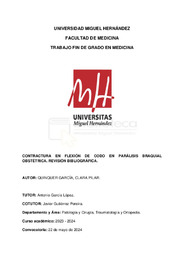Por favor, use este identificador para citar o enlazar este ítem:
https://hdl.handle.net/11000/33906Contractura en flexión de codo en parálisis braquial obstétrica. Revisión bibliográfica
| Título : Contractura en flexión de codo en parálisis braquial obstétrica. Revisión bibliográfica |
| Autor : Quinquer García, Clara Pilar |
| Tutor: García López, Antonio Gutiérrez Pereira, Javier |
| Editor : Universidad Miguel Hernández |
| Departamento: Departamentos de la UMH::Patología y Cirugía |
| Fecha de publicación: 2024-05-15 |
| URI : https://hdl.handle.net/11000/33906 |
| Resumen : Introducción: La parálisis braquial obstétrica (PBO) afecta aproximadamente a 0,4-4 de cada 1000 recién nacidos, con implicaciones significativas en la funcionalidad de la extremidad afectada, particularmente en la flexión del codo. Este trabajo revisa las diferentes modalidades de tratamiento y sus eficacias relativas para abordar la contractura en flexión de codo asociada a la PBO. Métodos: Se realizó una revisión sistemática de la literatura, incluyendo trece artículos seleccionados en las bases de datos PubMed y Scopus. Los estudios seleccionados abarcan enfoques tanto quirúrgicos como ortopédicos del tratamiento. Los primeros se basaron en la liberación anterior del codo en algunos casos con resección del olécranon; la osteotomía rotadora del húmero y la artrodiastasis de codo. El tratamiento ortopédico hizo uso de yesos y férulas seriadas, ortesis dinámicas e inyecciones de Toxina Botulínica. Se compararon resultados en términos de mejora del rango de movimiento (RDM) y de fuerza de flexión de la articulación pre y post intervención. Resultados: Los tratamientos no quirúrgicos, como los yesos seriados y las ortesis dinámicas, mostraron mejoras temporales en el RDM de extensión del codo. Sin embargo, estas mejoras no siempre fueron duraderas, indicando la necesidad de intervenciones repetidas o más invasivas en algunos casos. Por otro lado, las técnicas quirúrgicas demostraron mejoras más significativas y duraderas en el RDM, aunque no se logró la funcionalidad completa del codo en la mayoría de los casos. Discusión: Los hallazgos sugieren que mientras los tratamientos no quirúrgicos pueden ser adecuados para casos menos severos, las intervenciones quirúrgicas podrían ser necesarias para mejorar sustancialmente la calidad de vida en pacientes con contracturas más graves. La elección del tratamiento debe considerar la severidad de la contractura, las expectativas del paciente y su capacidad para participar en el tratamiento postoperatorio y rehabilitación. Conclusiones: Aunque los tratamientos quirúrgicos ofrecen mejoras más consistentes y duraderas, la necesidad de optimizar los enfoques no quirúrgicos sigue siendo crucial, especialmente para manejar casos menos severos de forma menos invasiva. Futuros estudios deberían enfocarse en comparar directamente las diferentes modalidades de tratamiento y en evaluar la satisfacción del paciente a largo plazo para determinar el impacto real de las intervenciones. Introduction: Obstetric brachial plexus palsy (OBPP) affects approximately 0.4-4 out of every 1000 newborns, with significant implications for the functionality of the affected limb, particularly in elbow flexion. This work reviews the different treatment modalities and their relative efficacies for addressing elbow flexion contracture associated with OBPP. Methods: A systematic review of the literature was conducted, including thirteen articles selected from PubMed and Scopus databases. The selected studies covered both surgical and orthopedic treatment approaches. The surgical approaches were based on anterior elbow release in some cases with olecranon resection; humeral rotatory osteotomy, and elbow arthrodiastasis. The orthopedic treatment utilized serial casts and splints, dynamic orthoses, and Botulinum Toxin injections. Results were compared in terms of improvement in the range of motion (ROM) and flexion strength of the joint pre and post-intervention. Results: Non-surgical treatments, such as serial casting and dynamic orthoses, showed temporary improvements in the ROM of elbow extension. However, these improvements were not always lasting, indicating the need for repeated or more invasive interventions in some cases. On the other hand, surgical techniques demonstrated more significant and lasting improvements in ROM, although full elbow functionality was not achieved in most cases. Discussion: Findings suggest that while non-surgical treatments may be suitable for less severe cases, surgical interventions may be necessary to substantially improve the quality of life in patients with more severe contractures. The choice of treatment should consider the severity of the contracture, patient expectations, and their ability to participate in postoperative treatment and rehabilitation. Conclusion: Although surgical treatments offer more consistent and lasting improvements, the need to optimize non-surgical approaches remains crucial, especially for managing less severe cases in a less invasive manner. Future studies should focus on directly comparing the different treatment modalities and evaluating long-term patient satisfaction to determine the real impact of the interventions. |
| Palabras clave/Materias: Parálisis Braquial Obstétrica Contractura en Flexión de Codo tratamiento quirúrgico tratamiento no quirúrgico |
| Área de conocimiento : CDU: Ciencias aplicadas: Medicina |
| Tipo de documento : info:eu-repo/semantics/bachelorThesis |
| Derechos de acceso: info:eu-repo/semantics/openAccess |
| Aparece en las colecciones: TFG- Medicina |
 La licencia se describe como: Atribución-NonComercial-NoDerivada 4.0 Internacional.
La licencia se describe como: Atribución-NonComercial-NoDerivada 4.0 Internacional.
.png)
